TheBOLT
Sage Hill School
20402 Newport Coast Drive, Newport Coast, CA 92657

Sage Hill School
20402 Newport Coast Drive, Newport Coast, CA 92657

By Doyoung Lee and Milan Desai
Sage Hill teachers continue to enforce their own policies on cellphone use in the classroom while the nation sees 35 states adopt legislation limiting phones in school hours this year.
Sage Hill is forging its own path amid the national discussion that has seen elected officials on both sides of the isle unite over shared concerns about the impact of cell phone use in the classroom. As a private institution, Sage Hill has the freedom to implement its own phone policy for students. Teachers are granted control over phone use in their classrooms.
Many teachers at Sage Hill believe high school students should already have the necessary discipline and respect to restrain themselves from phone use in class.
“Students are mature enough that they can deal with both the responsibility and consequences of it,” said Matt Vadeboncoeur, dean of academic technology and History teacher.
Elected officials across the nation appear to be less optimistic about students’ self-control over their devices. States widely vary in how they’re rolling out bans on phones at school. New York and Arkansas adopted the strictest form

of control among the states, a bell-to-bell cellphone ban that restricts phone access throughout the entire school day.
“I know our young people succeed when they’re learning and growing, not clicking and scrolling — and that’s why New York continues to lead the nation on protecting our kids in the digital age,” New York Gov. Kathy Hochul said in her public address.
New York City Public Schools (NYCPS) claims backpacks are not a suitable storage option and schools must provide alternate storage systems like lockers or magnetic pouches. While this rule is intended to minimize distraction, many educators, parents and students claim that these policies are excessive and a detriment to safety in the case of an emergency.
Consequently, other states like Kentucky and Utah have adopted milder forms of phone restriction that limit phones only during instructional times. Students are still allowed to use their phones between classes, and simply placing the phone out of sight in a backpack is often sufficient to meet in-class requirements. This moderate approach to phone policy invokes significantly more public

support: a 2025 Pew Research Center found that 74% of U.S. adults support an in-class ban compared to 44% for an all-day ban.
Around half of states simply require or recommend that schools provide phone policies to families. California follows this approach as the state with the highest student enrollment at 6.86 million.
“We know that excessive smartphone use increases anxiety, depression and other mental health issues — but we have the power to intervene,” California Gov. Gavin Newsom said after signing the bill last September.
The Phone-Free Schools Act requires all California public and charter schools to create new phone policies and enact them starting July 1, 2026. A recent study conducted by UC Irvine reveals growing support for this act, with an approval rating of 82% among California adults.
Districts around California have launched different phone policies in preparation for the new school year. While Fullerton and Los Angeles school districts require students to store away phones for the full school day, Newport-Mesa Unified School District limits restrictions to instructional time. Palm Springs Unified

School District permits non-disruptive use throughout the school day.
Students agree that they do not need phone holders to abstain from their usage.
“Much of the class content is important and valuable enough that I don’t feel the need to be on my phone,” junior Maxwell Lee said.
Sage Hill’s small average class size should be a considerable factor, Vadeboncoeur said.
“I’ve taught public [schools] as well, and you’re talking upwards of 40 kids per room sometimes. So that’s a huge disparity in terms of 40 phones to potentially manage, with students using them and causing distractions, versus 16,” Vadeboncoeur said.
Other teachers, however, are worried about students’ rising dependence on their phones and believe that strict phone policies are a necessary step in alleviating that.
“I enforce a strict cell phone policy, which I believe better helps students focus on the content and skills we are learning,” History teacher Stephen Schumacher said.
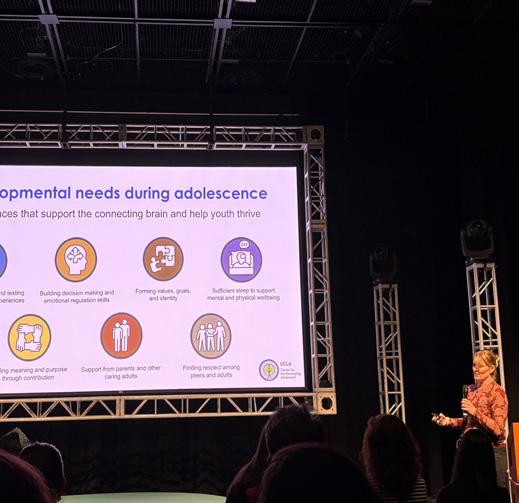
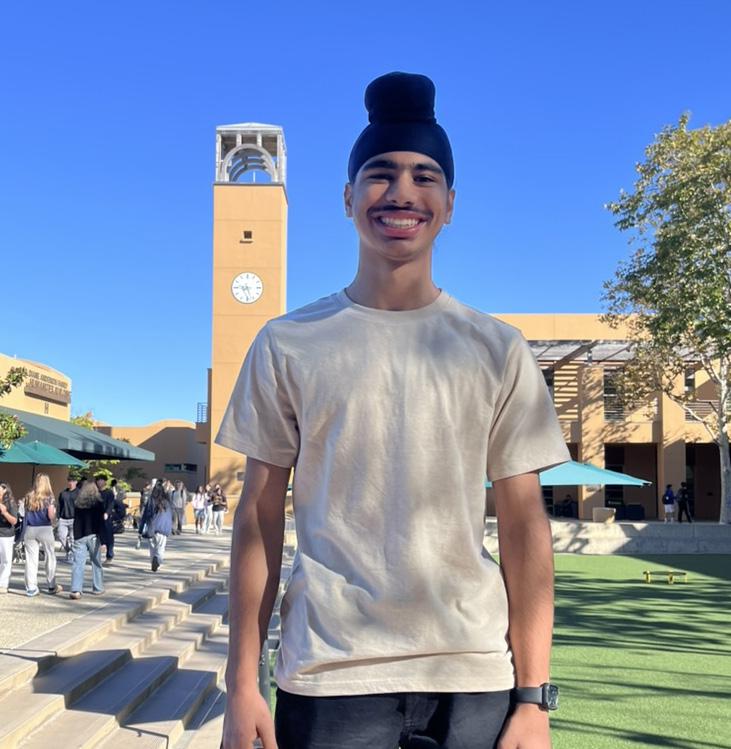
By Kenzie Chang
Tilda Landerer, a sophomore at Polytechnic School in Pasadena, lost her home in the Eaton fire on Jan. 9.
The Altadena resident recalled the painful uncertainty from the first hours of the Eaton fire.
“When I came home from school it was really windy. My dad was worried about the windows breaking and told me to pack an overnight bag,” Tilda said.
In the early days after evacuating, Tilda’s family stayed with a family friend before moving into an apartment closer to her school. The Landerer family then received the devestating call, notifying them that their house had burned.
Nine months ago, Los Angeles County faced some of the deadliest fires in state history, including the Eaton and Palisades fires. Both Altadena and the Pacific Palisades endured unprecedented damage to residential and commercial neighborhoods with over 16,000 structures destroyed in the two blazes, according to the California Department of Forestry and Fire Protection.
“I feel a lot closer to my [family since] we went through it together,” Tilda said. “I’ve noticed that when I refer to the new apartment I don’t call it ‘home’.”
While adjusting to her family’s new apartment was a difficult change, Tilda has begun to adapt to aspects in her new lifestyle. Tilda constantly reminds herself
to look at the positives of life.
“It was [sad] to see a tractor just take everything away,” she said, as the majority of the houses on her street were destroyed in the fires. Despite the loss in the neighborhood, Tilda feels that her neighborhood has become closer as residents exchanged information and united to rebuild their homes and Altadena as a whole.
Since the fires, Altadena residents have showed up to memorials and other community events, Tilda said. Her family and their neighbors meet for pizza every Monday to discuss their lives and upcoming building projects for their homes, a gathering that was only established after the fires.
The Palisades fire severely damaged St. Matthew’s Parish School, impacting its elementary and middle school families Reynaldo Macias, dean of student life and culture at St. Matthew’s, described the school as “very community focused,” which proved essential during the evacuation and rebuilding effort.
Macias was teaching seventh grade on a Tuesday morning when he was first alerted of the fire. As the fire burned toward the school, faculty tried to keep all students calm during the school’s evacuation. Since the fire’s fallout, students have resumed classes from the Water Garden, an office building complex in Santa Monica.
“I think the real interesting piece was

that [the] community was really strong prior to the fires,” Macias said. “Whether it’s the faculty or families, everybody leaned in.”
In the fire’s aftermath, the unified St. Matthew’s community knew how to step up for each other.
Macias commented on how stu-
dents in the classroom had “a little bit more grit, energy and gratitude” when it came to learning, and faculty members are constantly finding creative ways for the students to learn in their new school environment.
By Jessimi Lyu
Whether it be disagreements regarding decolonization movements or the fall of the Berlin Wall, public opinion eventually comes to light, even when facing censorship.
Now, as we enter an era of tumultuous politics and widespread disagreement, we face a practice that goes against the foundations of American government and individual liberties: penalizing those who speak ill of others.
On Oct. 15, Secretary of Defense Pete Hegseth issued new rules requiring reporters covering the Pentagon to agree not to publish information without government approval and restricting journalists’ movement in the Pentagon without escorts. Rather than undercut their own
journalistic ethics, the vast majority of professional reporters packed up their offices at the Pentagon and turned in their access badges. They’ve vowed to continue covering the U.S. military from outside the building and maintain the confidence of trusted sources.
This continues an anti-free press playbook carried out by the administration over the past 10 months.
When the Trump administration took office, Karoline Leavitt was appointed to White House press secretary, implementing a media strategy that established that public statements openly opposing the government would carry repercussions.
The Trump administration has doubled down on its restrictions for media outlets, suing The New York Times for $15 billion
The Bolt is a student newspaper and serves the public forum at Sage Hill School. Its content - news, editorial, opinion, and feature - is protected by Education Code 48907, the state student rights law and the California Constitution which guarantees all citizens the right of freedom of speech and of the press. Opinions expressed do not represent the views or beliefs of Sage Hill School and its administration. The Bolt accepts signed letters to the editors from members of the Sage Hill community which may be posted as comments at lightningboltonline. com, or addressed to the Editors-in-Chief Arya Rawal, Katelyn Yeh and Maya Desai and put in their mailboxes on campus. These letters may not exceed 150 words or they will be edited for inclusion.
Editors-in-Chief
under claims that the media company has become “a full-throated mouthpiece of the Democrat Party,” NPR reports. Trump was forced to refile the lawsuit after a federal judge dismissed the complaint as unnecessarily lengthy and “florid.”
Late-night television host Jimmy Kimmel was also temporarily suspended after the Trump-appointed FCC Chairman threatened to review the broadcast license issued to the ABC News’ parent, Walt Disney Co., after he characterized President Trump’s reaction to Charlie Kirk’s death as childlike.
To censor the voices of American journalists is a blatant infringement on American rights. The First Amendment of our Constitution explicitly specifies
Arya Rawali (Bolt), Katelyn Yeh (Bolt) & Maya Desai (Online)
Editorial Board
Amy Choi, Taite Nicholson, Kenzie Chang, Maria Neemuchwala, Isabella Huang, Doyoung Lee, Ella Wang, Jenny Li, Linda Liu, Tina Tahbaz, & Johnathan Yan
Writers
Suri Li, Elisa Xu, Nate Yoo, Mika He, Grace Ma, Carson Ellis, Leo Lin, Milan Desai, Nicole Bo, Alexis Prokopuk, Shawn Huan, Nathan Tang, Aniline Umstaetter, Zahra Hakimi
Photographers and Artists
Nathan Tang, Leo Lin, Aniline Umstaetter, Tina Tahbaz, Robbie Watson, Grace Ma, Elisa Xu, Zahra Hakimi
Adviser Daniel Langhorne
freedom of the press, and while conservatives have generally veered towards Originalist or Textualist interpretations of the Constitution, they have strayed from those values to protect themselves from criticism.
If we allow the government to infringe upon our First Amendment liberties, then the discourse that enters our workplaces, schools, and homes will lack the varied perspectives and complexity of thought that emerges when discussion is fostered.
The public should consider the ramifications of having their voices stifled and leaving themselves vulnerable to the next attack on their liberty.

By Leo Lin & Mika He
Ever since joining Sage Hill School, sophomore Zack Longo has dedicated himself to running cross country and not looked back. In his freshman year, Zack closed in on the Sage Hill cross country record, but came just short, running his best time of 16:07 at the 43rd Annual Woodbridge Cross Country Classic.
Entering the Fall 2025 season, Zack picked up where he left off in his freshman year. At the 2025 Dana Hills Invitational at Dana Hills High School, Zack broke the Sage Hill three-mile record.
Entering just his second race of the season, Zack was confident he could break the school record. Before the race, he had inched below a 5:00 mile pace, which comes out to a 15:00 three-mile time.
“15:29 was not a scary task at all,” Zack said.
Also running in the 2025 Dana Hills Invitational was fellow Sage Hill cross country star junior Nate Yoo. During the race, Nate got off to a quick pace with his long strides, and Zack settled in behind him, trying to stay close.
“In the moment, it was
like any other race. It felt hard to hold onto my teammate, Nate, but then, once I was close enough to finish, my legs were fresh enough to close fast,” Zack said.
Both Zack and Nate, with their times of 15:29 and 15:35 at the Dana Hills Invitational, surpassed the 18-year-old school record of 15:39 set by Connor Rose in 2007.
When training, Zack follows his personally tailored plan that Cross Country Head Coach Mario Flores sets for him. In his regimen, Zack alternates between workouts and a variety of runs, including long and tempo runs and strides before race day.
“Practicing is mainly running, but also other aspects like plyometrics or strength training that are good for running form,” Zack said.
In addition to Zack’s training program, Assistant Coach Sergio Flores gives Zack plyometric workouts to improve responsiveness in his form.
Zack attributes his cross country success to his consistent and rigorous training. More importantly, his passion for running stems from a desire to challenge himself.
“I like challenging myself in workouts and seeing

progress. For example, I like looking back at old PR times and trying to rep them in workouts now,” Zack said.
For the remainder of the season, Zack aims to make
the CIF State Cross Country Championship and run a strong time. He also hopes to beat some competitors, specifically from his former middle school, St. Margaret’s
Episcopal School.
Zack’s high school cross country career is still young, but he sets his long-term sights on qualifying for the Nike Cross Nationals.
By Meredith Carroll
After last year’s standout season, Girls’ Volleyball was back on the court, showing their incredible energy, teamwork and dedication.
With several returning players and some impressive new talent on the roster, Lightning Volleyball has fully jumped into the schedule after winning the Pacific Coast League last year.
The team ended its season with a 20-12 record. Thousand Oaks knocked them out of the CIF-SS playoffs with a 1-3 loss at an away game on Oct. 21.
Heach Coach Dan Thomassen sought to build on the winning foundation set by last year’s seniors and juniors.
The team has seen a mix of close matches and decisive wins, which makes them optimistic for their future.
Sophomore captain and outside hitter Eve Fowler noted how the team’s chemistry has grown stronger with each game played.
“It’s really our team, as a whole, coming into every game with a lot of energy,” Eve said. “We are an unselfish team, and everyone brings each other up.”
Early victories in the pre-season helped the team establish momentum, but a few close wins reminded them of the competitive edge needed every rally.
“My favorite games so far have been against St. Margaret’s and Rosary,” Eve said. “We battled from the energy on the bench to the energy on the court. And we also had the Boys’ Basketball team there in the gym supporting us, and that was just really cool.”
The team’s preparation has emphasized strength and ball control. At practice, the team scrimmages and runs drills that push the players to be their best. Players worked to improve key areas for victory, including coordination and communication.
With league matches before the playoffs, both players and Lightning fans are excited to see how the rest of this season unfolds. The team’s growing chemistry and determination have created optimism for what is to come. The players are motivated to keep building up the momentum and finish the season stronger than ever.
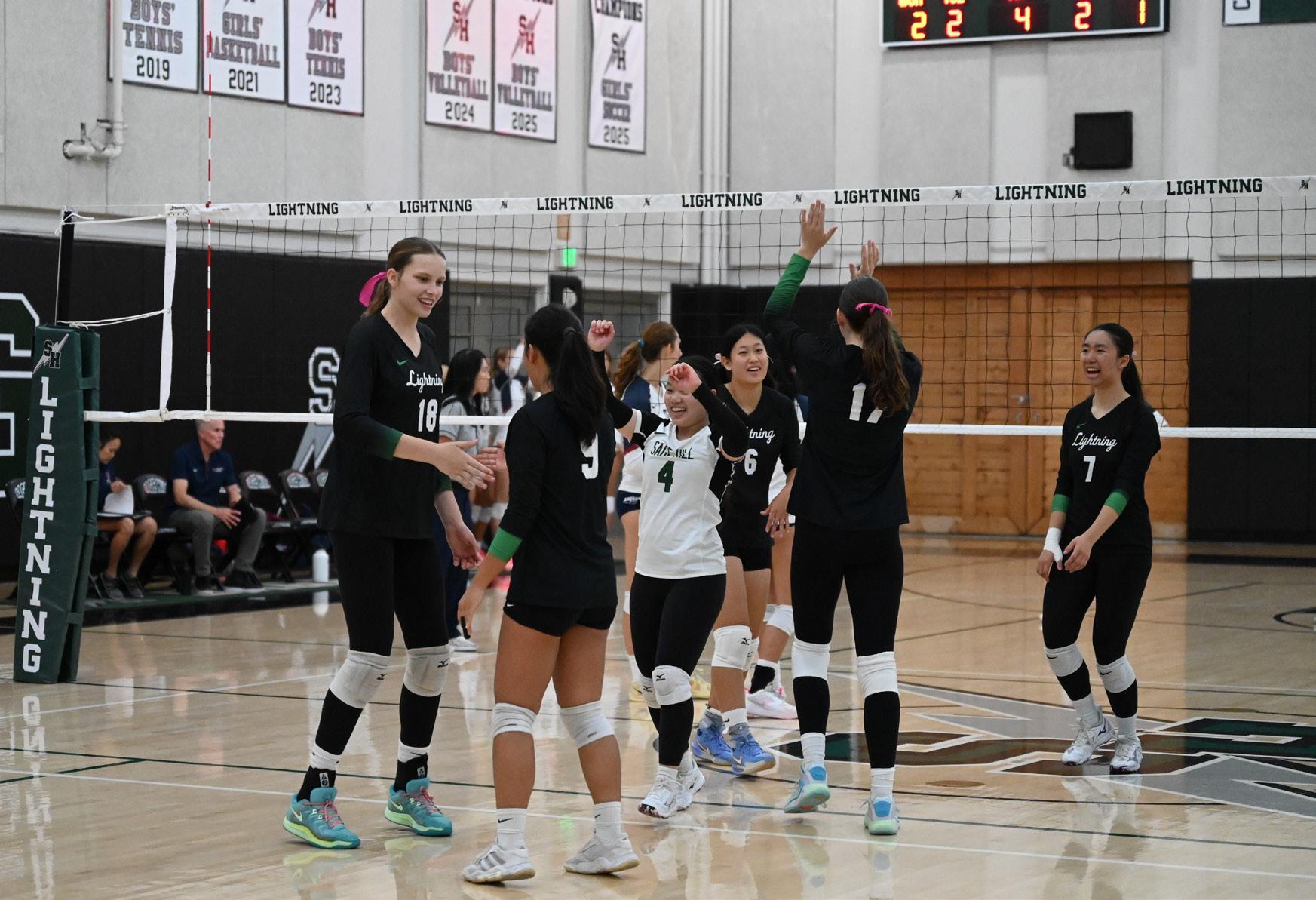
“Although it’s going to be challenging at times, we are improving as a team and putting in a lot of effort in our practices, games and scrimmages,” sophomore and right
side defender Vianna Kashani. Teamwork and positive energy hold the key to a strong season next year.
“My favorite part about playing volleyball is being with my team. Everyone wants to be there, and we all love and support each other,” Eve said. “Win or lose, it is always about the team.”
By Maria Neemuchwala
Patterns of Civilization and AP World History teacher
Steven Duxbury has stood out at Sage Hill through his meaningful lectures and discussions that push students to grow their understanding of history.
Duxbury has been fond of history since a young age. He particularly fell in love with the subject during his seventh-grade experience with a special world history teacher, who was a World War II veteran.
“He had stories of the war that just got me really... excited about history,” Duxbury said.
In college, Duxbury further pursued this passion, majoring in History at Cal State Fullerton. Since then, he has taught at a wide range of schools, totaling 37 years of teaching experience. He started out teaching at smaller Christian middle schools for around 12 years. He then moved to Fairmont Preparatory Academy, working at the middle and later
the high school levels. After a 20-year stint with Fairmont, Duxbury started at Sage Hill in 2021.
In his free time, Duxbury enjoys riding anything on two wheels, like mountain bikes, dirt bikes, and his motorcycle. He also loves watching history related period pieces and documentaries and traveling to new places.
“A main part of my travels is looking at the history of the places I visit,” Duxbury said.
When teaching students, Duxbury loves seeing his students succeed when they commit to something. He especially enjoys witnessing the moment within his students when they experience the “click” and are able to grasp a new concept.
Teaching has taught Duxbury a wide range of lessons, especially with patience. Having a type A personality, he has had the urge for others to get things done in a certain way, but teaching has taught Duxbury to step back and give

each person their own time and freedom in their tasks.
Duxbury hopes that students feel that he has helped get them where they need to be, while remaining earnest in fulfilling his job.
“I want to help students
achieve their goals and succeed at what they’re doing, and leave a positive impact on their learning experience,” Duxbury said.
By Maria Wang Origami,
the traditional Japanese art of paper folding, was practiced by Japanese monks and religious leaders in ceremonies thousands of years ago. Origami has evolved into a popular art form practiced worldwide.
The Origami Club was founded two years ago by senior Brady Bai and provides a creative space where students can explore the art of origami and develop a deeper appreciation for a craft that is far more than paper folding.
“We are genuinely passionate about origami,” Bai said. “We didn’t found this club just to offer volunteer hours or give out leadership roles.”
Holding weekly meetings during Friday lunch, the Origami Club offers a “learn at your own pace” approach to the craft of origami, no prior experience required. Attendees learn how to transform pieces of paper into a variety of three-dimensional sculptures without using scissors or glue. These sculptures range from simple paper cranes and other
animals to more complex figures, in a variety of colors.
The Origami Club also collaborates with other groups and organizations, hosting workshops that teach participants how to craft origami. The Club recently partnered with the Anime Club to host an Anime Figure Origami Session, where students learned how to fold paper models inspired by popular anime characters.
Beyond learning how to craft origami, club members bond with one another and form genuine connections. Bai said students enjoy working together on origami projects, cultivating a sense of comradery among members of this community.
Student enjoy the club’s setting for relaxation and an informal alternative to Sage Hill’s more academically competitive clubs
“The Origami Club has a very social, lively, and collaborative atmosphere, which is the hallmark of this club,” senior Camila Garduno Mora said.

By Isabella Huang
Dr. Candice Odgers, professor of Psychology and Informatics
at UC Irvine, spoke to the Sage Hill community about the mental health impact of digital technology and social media during a Sage Center Speaker Series on Sept. 30.
Odgers, whose research focuses on the intersection of youth development and digital media, addressed common misconceptions about screen time and teen mental health. She has authored more than 100 scientific publications, and her work has been featured in outlets including The Economist, The London Times, Scientific American and The Washington Post.
With over 30 years in mental health research, Odgers said the rise of mobile phone use among adolescents in 2008 inspired her to focus on digital technology’s impact on the adolescent brain. Since then, she has conducted large-scale surveys and meta-analyses examining the relationship between technology use and mental health symptoms in youth.
Contrary to popular belief, Odgers said social media use has only a small link to negative mental health outcomes in teens. She argued that fears about screen time are often exaggerated and that its effects depend heavily on individual circumstances.
“You look across all those studies, and this is the surprising part: usually, the effect of screen time on indicators that we care about is very close to zero,” Odgers said.
The slight positive or negative effects of social media were tiny and explained less than one percent of the variation observed in research, she said.
Highlighting a key nuance, Odgers emphasized that although social media and screen time aren’t the main drivers of the youth mental health crisis, it remains necessary to regulate the potentially exploitative practices of tech companies.
We need to regulate tech companies. And it can also be true that social media and time online, the way that our young people are using it, is not the main driver of their mental health crisis today,”
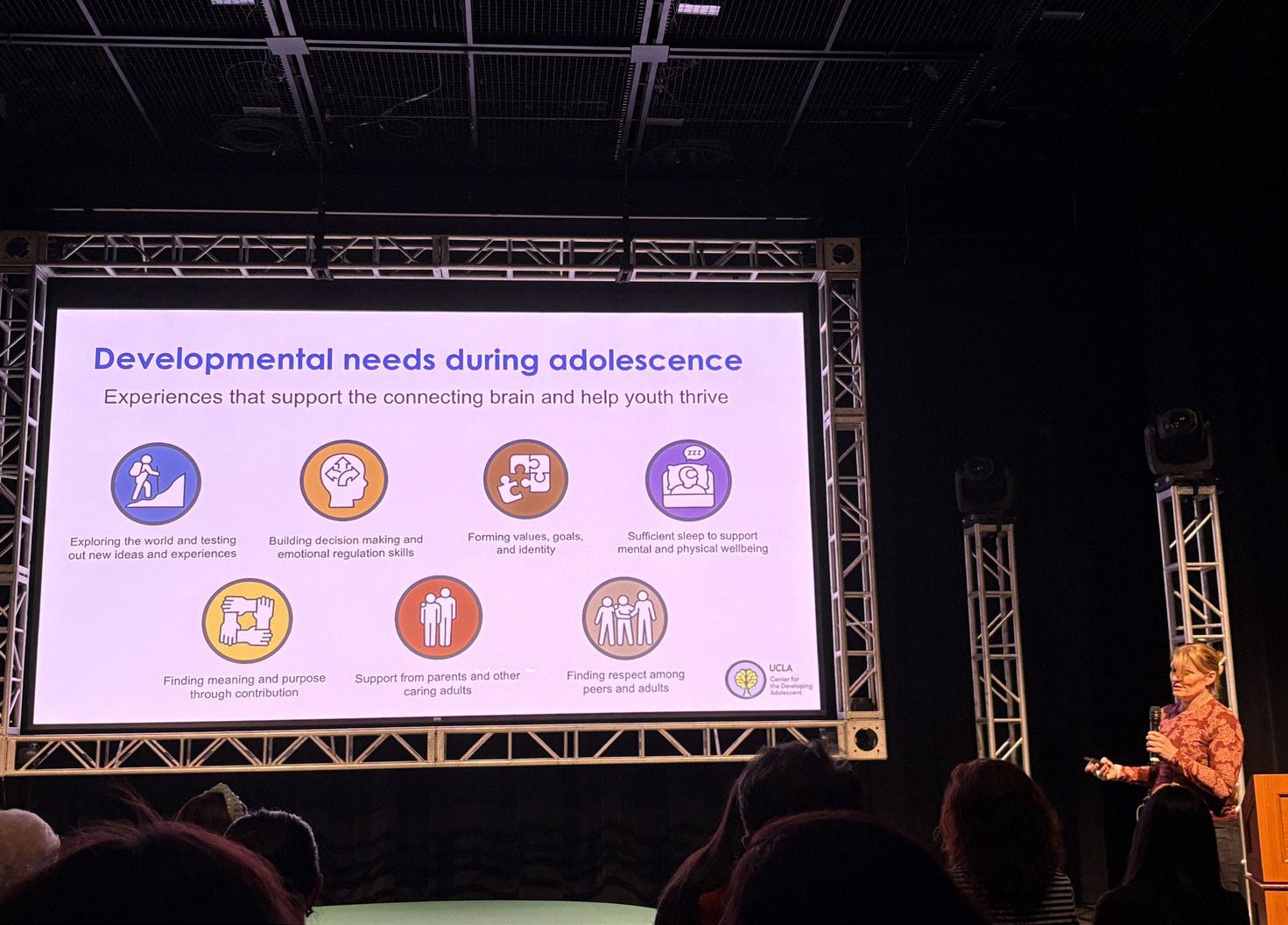
Odgers said.
However, she added that the future of tech regulation remains nebulous. Without consensus on the implementation and actors involved in reform, legislation to address harmful practices is in a stalemate.
Still, Odgers expressed optimism that continued research
and dialogue can pave the way for eventual policies.
“I think we’re in a place where it makes sense to take a safety first approach, so lots of education. And we’re going to have to talk to the young people in our homes,” Odgers said.
By Samuel Jindal and Nate Yoo
As the school year kicks into full swing, many Jewish students and faculty at Sage Hill are entering one of the most sacred periods of the year, the High Holy Day season. Spanning Rosh Hashanah, Yom Kippur and Sukkot, the trio of celebrations marks both the spiritual New Year and a time of renewal.
“This time of year is always a very special one for Jewish people because obviously all the holidays are so close together,” junior Liam Sapan said.
Rosh Hashanah, which translates to “head of the year,” celebrates the Jewish New Year with traditions such as attending synagogue services, sharing festive meals, and most uniquely sounding the shofar, a ram’s horn that symbolizes awakening and reflection. This holiday is also
often a time for introspection and reflection, marked by eating foods like honey and apples for a sweet year ahead.
“My family and I mainly celebrate Rosh Hashanah together. Family is definitely a huge part of most Jewish holidays,” freshman Miles Tarman said.
Following Rosh Hashanah is Yom Kippur, considered the holiest day in the Jewish calendar. Known as the Day of Atonement, observance of this sacred holiday includes a 25-hour fast where worshippers refrain from food and drink to focus on spiritual reflection and prayer.
Similar to Shabbat, the weekly Jewish day of rest, no work is to be done during Yom Kippur. Due to the nature of this holiday, many members of the Sage community find themselves balancing this solemn day with academic respon-
sibilities, seeking ways to stay spiritually present while juggling schoolwork.
“I just want more people to know that these holidays are not just another holiday or a funky name,” Tarman said. “There is a meaning behind them and that it actually means something to the culture.”
Students and faculty also cited the welcoming nature of their peers and classmates as a factor that made celebrating these holidays feel more natural and comfortable.
“I definitely feel supported. A lot of people have questions and want to know more, which I appreciate. It’s a big part of my life being Jewish so for the community to jump in and wanting to learn more means a lot,” said Catie Chase, coordinator for the young alumni and Girls’ Volleyball
programs.
After the solemn reflection of Yom Kippur comes Sukkot, a weeklong celebration filled with outdoor festivities. Families build sukkahs, open-air huts covered with branches and leaves, and eat beneath the stars. For many Jewish students at Sage Hill, the holiday’s outdoor traditions bring a refreshing change of pace and an opportunity for rest.
As the High Holiday season comes to a close, Jewish community members return to campus carrying a renewed sense of purpose.
At Sage Hill, these traditions remind individuals that faith isn’t confined to religious practices; it’s found in how students treat one another and support their peers to build a tight-knit community.
By Nicole Bo
Based on a best-selling trilogy by Jenny Han, the television adaptation of “The Summer I Turned Pretty” has become a global sensation and the talk of the summer, streaming in over 240 countries. Its third and final season premiered in July, and it reached an incredible 70 million viewers in just 70 days. The series’ viewership has tripled since its first season, demonstrating its lasting impact.
Starring Lola Tung, Christopher Briney, and Gavin Casalegno, this live-action series is a coming-of-age drama that centers around Isabella “Belly” Conklin and her complicated love triangle between the Fisher brothers, Conrad and Jeremiah. Set in the fictional seaside town of Cousins Beach, the show explores themes of love, family, friendship, and personal growth. In the first season, Belly finds herself torn between the brothers while dealing with the heartbreak of losing their mother, Susannah. The second season ends as Belly finds a sense of closure when she begins a relationship with Jeremiah.
However, at the start of season three, Belly breaks off her engagement to Jeremiah and moves to Paris for a fresh start, unaware that Conrad had followed her there. The finale delivers the long-awaited resolution, as Conrad and Belly finally manage to successfully begin a new relationship.
More than just a love story, “The Summer I Turned Pretty” is relatable for younger viewers who are struggling to navigate love and maturity. The show captures the emotional transition from an overlooked teenager to a young adult

experiencing heartbreak, loss, and independence. This is what makes it so resonant for youth across the world. Critics and fans alike have applauded the show’s realistic dialogue and emotional performances, especially from Cristopher Briney, whose portrayal of Conrad brings depth to a character that’s torn between the past and future versions of himself.

It is no surprise that the third season is Prime Video’s most-watched TV season ever among women ages 18 to 34. Additionally, the soundtrack used for this series is widely praised, as the blend of popular artists such as Chappel Roan, Sabrina Carpenter, Ariana Grande, and Olivia Rodrigo has increased viewership. Some artists who had their music
featured on the show experienced up to a 6,000% increase in song sales and streams.
Overall, “The Summer I Turned Pretty” is a tender and nostalgic story about vulnerability, love, loss, and the transition into adulthood. The series encapsulates what it means to grow up, let go, and find yourself.
R eview: K aTSeye x Ga P iS a n “eyeKoniC” a d
By Suri Li
Months after the release of KATSEYE’s single “Gnarly,” the upand-coming international girl group took the world by storm once again with new content to deliver, this time through a collaboration with Gap. The “Better in Denim” crossover commercial with KATSEYE dancing to Kelis’s “Milkshake” exploded across social media platforms, garnering over 400 million views within the span of three days.
The ad featured iconic low-rise jeans and casual Y2K-inspired styles, meshing early 2000s nostalgia with a modern, youthful twist. Its unique choreography and transitions also allowed the ad to feel more like a performance video rather than a typical ad, keeping viewers hooked long past the usual five seconds it takes to skip a commercial. At the same time, the commercial appealed to Gen Z’s changing notion of branding.
The company evolved beyond merely providing staples, showcasing their cross-promotional savvy through influencers and setting their sights on an increasingly saturated
fashion market. KATSEYE’s global presence and group performances resonated well with the public, and thus, in intersection with Gap’s minimalist aesthetic, the commercial was able to appeal to both new and longstanding fans.
Yet, more than going viral, the campaign was a welcome release amid the negative connotations surrounding influencer brand deals.
In particular, the Sydney Sweeney x American Eagle ad drew unwelcoming attention for its conservative imagery. Sweeney’s ad sparked conversations on how celebrity commercials can reflect political and cultural divides. The KATSEYE x Gap Ad presented denim as a form of globalized influence and identity, with members representing different nationalities and backgrounds, perfectly illustrated an international campaign with an interconnected worldview.
“This is denim as you define it. Your individuality. Your self-expression. Your style. Powerful on your own. Even better together,” the ad’s description notes.
By Grace Ma
R. F. Kuang’s latest book, “Katabasis,” was released after months of anticipation from readers. In this new dark academia fantasy novel, Kuang skillfully combines classical philosophy with themes of magic to create a riveting story of obsession and knowledge.
The book follows two Cambridge graduate students, Alice Law and Peter Murdoch, on their journey to Hell to rescue their professor, Jacob Grimes, after his death. The two rivals set off determined to find Professor Grimes in order to receive a recommendation letter that will change their academic futures.
Alice and Peter face dangerous challenges that test their character and abilities. They run into a deity called Weaver Girl, who offers red
and green apples, representing their choice to proceed alone or together. When they choose differently, Peter is captured by the Weaver Girl and the two are attacked by the bone creatures. Thankfully, they are saved by a boatwoman named Elspeth Bayes. As the two venture further, they learn more about each other and work together to overcome obstacles.
The idea of death becomes apparent as they explore Hell. Kuang explains this idea by using the paradox of someone existing in the world at one moment and being gone the next. Despite being reminiscent of the Roman myth of Orpheus and Eurydice, the story gives readers a fresh perspective of Hell by using it as a foundation to convey the underlying theme of toxic
MuSic R eview: unR aveling ‘ tHe liFe oF a SHowgiR l ’
By Colette Moshayedi & Elisa Xu
Pop artist Taylor Swift released her 12th studio album titled The Life of A Showgirl on Oct. 3. Produced by Max Martin and Shellback, the album received over 1.5 billion streams in its first week. Despite her previous studio album “The Tortured Poets Department” stylistically leaning towards melancholic indie pop, Swift’s new album includes more upbeat tracks, reflecting her current life as a modern “showgirl” and her relationship with Travis Kelce.
Although “The Life of A Showgirl” has more surface-level lyricism, we enjoyed the upbeat feel that makes Swift’s songs so memorable. It is clear that Swift’s intention with this record was to appeal to a larger audience beyond her own fanbase with catchy pop melodies and easy-to-remember lyrics. We enjoyed that the album incorporated fun chord progressions as well as catchy tunes.
Being listeners who lean toward Swift’s older albums and genres such as “Folklore” and “Evermore,” we thought that these new songs were less emotionally resonant than her previous works. Additionally, Swift’s introspective direction of the album differs from her previous works, which often followed fictional narratives. The image of being a “showgirl” was less relatable for the both of us, as
being a popstar isn’t something the average person can resonate with.
Public reception of the album on social media has been incredibly divisive. Some people claim that Swift has written racially insensitive and microaggressive lyrics in her songs “Opalite” and “Wi$h Li$t.” Additionally, Swift has received accusations of interpolation, or re-recording melodies from the work of another artist. Listeners have noted similarities between Swift’s “Wood” and the Jackson 5’s “I Want You Back,” as well as between her song “Actually Romantic” and the Pixies’ “Where Is My Mind?”
Despite this criticism, many fans believe that the album still explores important themes, especially the dark side of fame. Swift has also been very public about her relationship with Kelce, announcing her engagement to the Kansas City Chiefs tight end just weeks ago. Evidently, she includes aspects of her romantic life in the album, reflecting the nuance of living in the spotlight.
“The Life of a Showgirl” marks a vibrant chapter in Swift’s career. While the album trades lyrical depth for mainstream pop energy, it captures her evolution as both an artist and a public figure navigating love and fame under constant scrutiny.
academia.
This book explores ambition, intellectual obsession and the extent to which people will go to achieve their academic dreams. Alice and Peter’s eventual vulnerability regarding their personal struggles brings subjects like chronic illness into view.
Due to Kuang’s extensive use of philosophical concepts and academic ideas, “Katabasis” can come off as too academic or difficult to understand. However, it’s perfect for readers looking to immerse themselves in a world of magic, academia and fantasy.
Readers who enjoyed Kuang’s style of writing in “The Poppy War” or “Babel” would appreciate the similar storytelling in “Katabasis.”


For answers to the crossword puzzle go to: lightningboltonline.com/category/arts-entertainment/
By Taite Nicholson
‘
The curtains of the Kazu Fukuda Black Box Theater opened for an intimate audience of Sage Hill faculty, students and families on Nov. 5. After a brief introduction by Theatre program director Mary Kildare, the Invited-Dress Rehearsal of “Noises Off,” a farcical play-within-aplay written by Michael Frayn, began with the ringing of a telephone.
The creative comedy follows a theater troupe’s chaotic rehearsal and production of the fictional play “Nothing On.” The show offers the audience a behind-the-scenes look into an intentionally disorganized on-stage and backstage performance. Driving the mayhem are the eccentric personalities of the performers, the several romantic affairs between cast members and complications with props, including troublesome telephone wires, IRS letters and household doors.
The humor of the production is in its dysfunction.
“Everything goes wrong. Things start falling apart,” said senior Mia Ciuni, who plays the actress Brooke Ashton and the character Vicky, a promiscuous tax authority worker. “It’s one of the harder plays we have done here because there is so much going on all at the same time.”
Senior Julia Ball, acting as stage manager and assistant director agreed.
“There’s like a million props and a lot of set changes and a lot of stuff for our backstage [technicians] to do. But it’s a lot of fun,” she said.
“Noises Off” is segmented into three acts: an opening dress rehearsal (which the fictional actors mistake for the tech rehearsal), a second act featuring a 180-degree set rotation for a backstage view during their performance and an on-

stage final rehearsal of the last leg of the troupe’s tour.
“The whole thing is kind of one scene. Everybody’s on-stage basically the whole time,” Assistant Director and Senior Paul Cauffman said. “My favorite act is Act II because it’s organized chaos where everything has to happen at exactly the right time so that the right reactions take place.”
Humorous motifs such as plates of sardines, lost contact lenses and a box of tax files provide the audience with
references to directly track the pandemonium occurring on-stage. As the personal relationships of the characters become more complex, the show becomes less about performing “Nothing On” and more about the emotional (and physical) drama that happens behind the scenes, which often bleeds (quite literally) into the onstage production.
Exceptional performances from seniors Isaac Alegria, Sophia Montgomery, Mia Ciuni and Arman Hamidi, as well as sophomore Sam Gabriel, punctuated the
clever script with great comedic timing and hilarious execution.
From mistaken hauntings to love triangles to unexpected mother-daughter reunifications, Sage Hill’s production of “Noises Off” has it all. In its essence, it’s about doing one’s best amidst complete havoc. Perfectly capturing the message of the production were Kildare’s opening remarks: “Keep calm and carry on—and enjoy a laugh in the in between!”
“Noises Off” plays the Black Box Theater from Nov. 6 to Nov. 8.
By Milan Desai
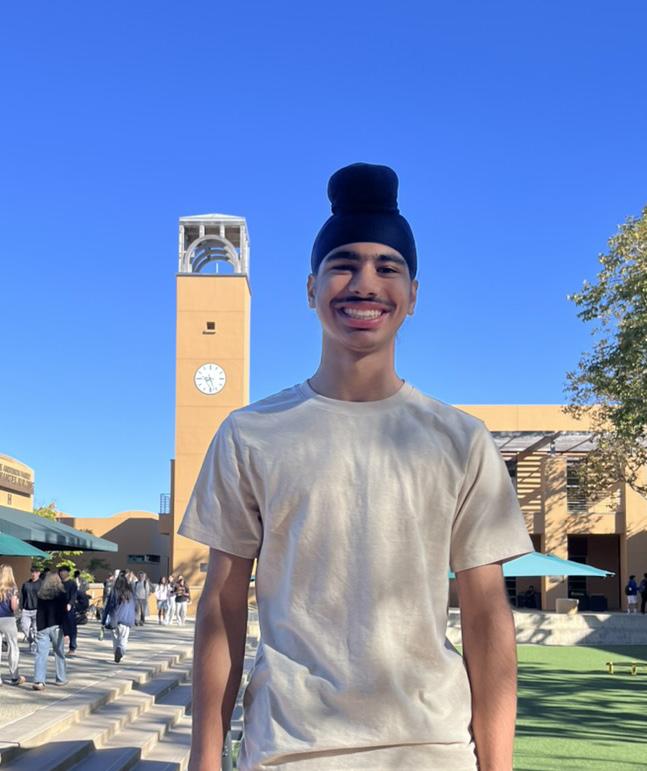
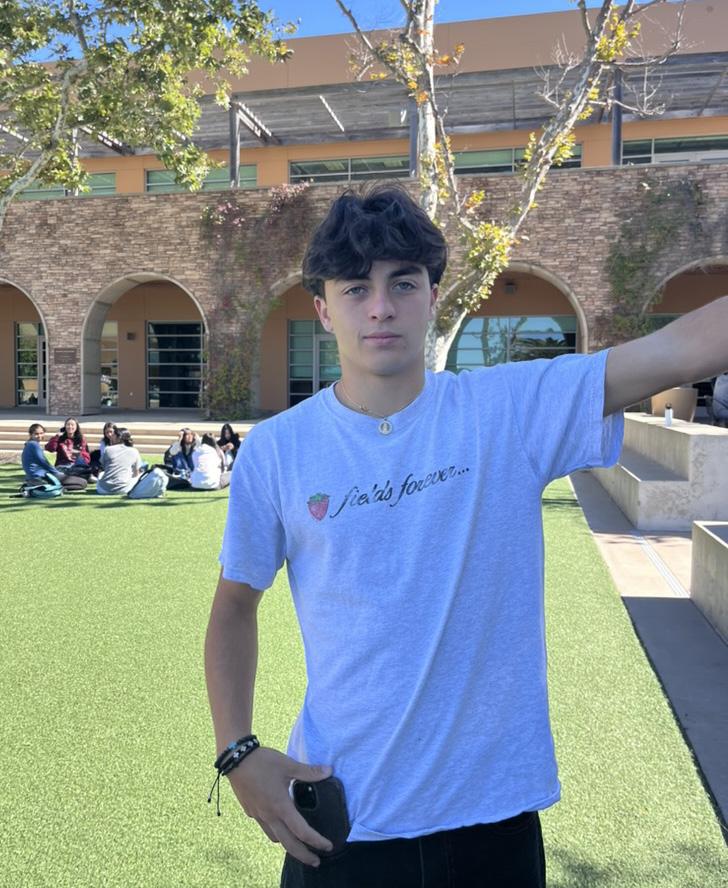
“I


- Junior Ethan Guan “I